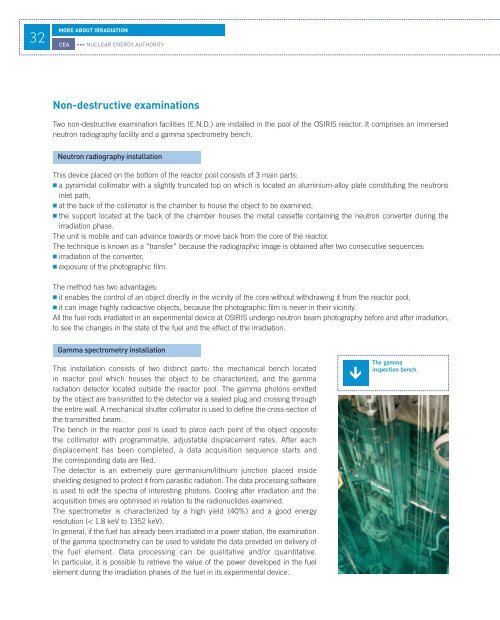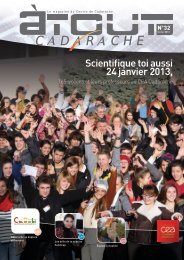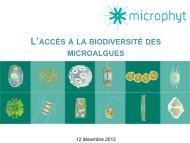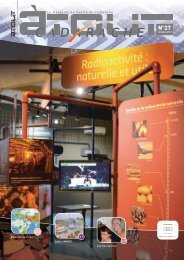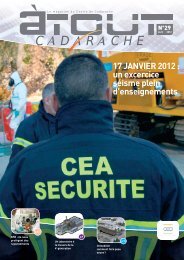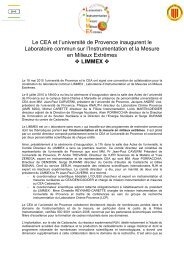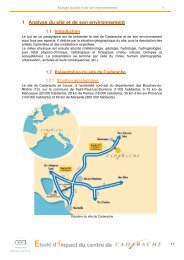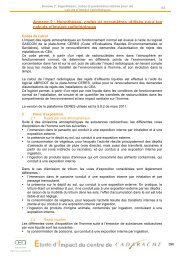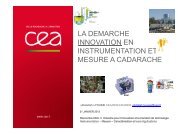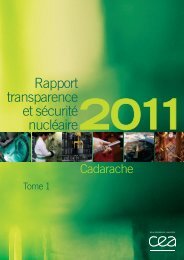OSIRIS REACTOR - Centre de Cadarache - CEA
OSIRIS REACTOR - Centre de Cadarache - CEA
OSIRIS REACTOR - Centre de Cadarache - CEA
- No tags were found...
You also want an ePaper? Increase the reach of your titles
YUMPU automatically turns print PDFs into web optimized ePapers that Google loves.
32MORE ABOUT IRRADIATION<strong>CEA</strong>••• NUCLEAR ENERGY AUTHORITYNon-<strong>de</strong>structive examinationsTwo non-<strong>de</strong>structive examination facilities (E.N.D.) are installed in the pool of the <strong>OSIRIS</strong> reactor. It comprises an immersedneutron radiography facility and a gamma spectrometry bench.Neutron radiography installationThis <strong>de</strong>vice placed on the bottom of the reactor pool consists of 3 main parts: a pyramidal collimator with a slightly truncated top on which is located an aluminium-alloy plate constituting the neutronsinlet path, at the back of the collimator is the chamber to house the object to be examined, the support located at the back of the chamber houses the metal cassette containing the neutron converter during theirradiation phase.The unit is mobile and can advance towards or move back from the core of the reactor.The technique is known as a “transfer” because the radiographic image is obtained after two consecutive sequences: irradiation of the converter, exposure of the photographic film.The method has two advantages: it enables the control of an object directly in the vicinity of the core without withdrawing it from the reactor pool, it can image highly radioactive objects, because the photographic film is never in their vicinity.All the fuel rods irradiated in an experimental <strong>de</strong>vice at <strong>OSIRIS</strong> un<strong>de</strong>rgo neutron beam photography before and after irradiation,to see the changes in the state of the fuel and the effect of the irradiation.Gamma spectrometry installationThis installation consists of two distinct parts: the mechanical bench locatedin reactor pool which houses the object to be characterized, and the gammaradiation <strong>de</strong>tector located outsi<strong>de</strong> the reactor pool. The gamma photons emittedby the object are transmitted to the <strong>de</strong>tector via a sealed plug and crossing throughthe entire wall. A mechanical shutter collimator is used to <strong>de</strong>fine the cross-section ofthe transmitted beam.The bench in the reactor pool is used to place each point of the object oppositethe collimator with programmable, adjustable displacement rates. After eachdisplacement has been completed, a data acquisition sequence starts andthe corresponding data are filed.The <strong>de</strong>tector is an extremely pure germanium/lithium junction placed insi<strong>de</strong>shielding <strong>de</strong>signed to protect it from parasitic radiation. The data processing softwareis used to edit the spectra of interesting photons. Cooling after irradiation and theacquisition times are optimised in relation to the radionucli<strong>de</strong>s examined.The spectrometer is characterized by a high yield (40%) and a good energyresolution (< 1.8 keV to 1352 keV).In general, if the fuel has already been irradiated in a power station, the examinationof the gamma spectrometry can be used to validate the data provi<strong>de</strong>d on <strong>de</strong>livery ofthe fuel element. Data processing can be qualitative and/or quantitative.In particular, it is possible to retrieve the value of the power <strong>de</strong>veloped in the fuelelement during the irradiation phases of the fuel in its experimental <strong>de</strong>vice.The gammainspection bench.


